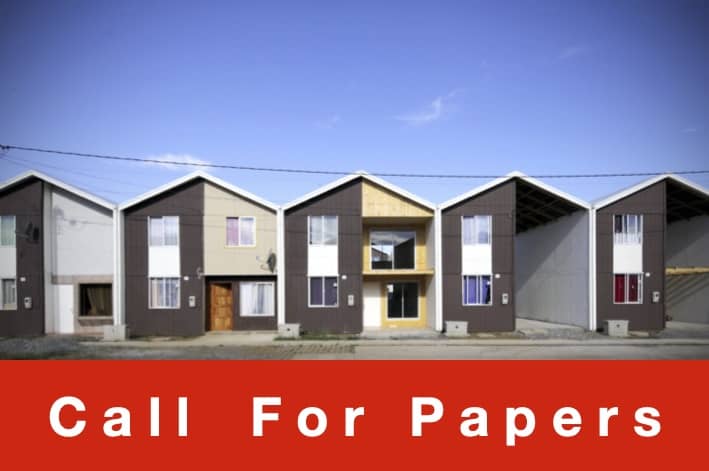
www.buildingsandcities.org/calls-for-papers/housing-adaptability.html
Housing Adaptability

Guest Editors: Sofie Pelsmakers (Tampere University) and Elanor Warwick (Clarion Housing)
Abstract submissions closed on 7 June 2021
Over the past 40+ years, the size of urban dwellings has diminished in many Western and Asian countries, resulting in negative impacts on residents' needs and activities (Park, 2019; Tunstall, 2015). At the same time, an increasing range of activities is expected to be performed at home. One set of possible solutions involves increasing the adaptability of spaces within the dwelling. Other solutions may reconsider the relation between domestic privacy and public cohabitation / shared facilities. Original research, policy analysis, methods and synthesis papers are sought that investigate, analyse and connect different aspects and/or disciplines of adaptable living environments (i.e. inhabitants, the individual dwelling, the housing block, spaces adjacent to homes and their neighbourhood).
Aims
This special issue will explore multiple perspectives for both developed and developing countries:
● Concepts of adaptability in housing and their
implications across a range of issues, scales (e.g. internal or external rooms,
dwellings, building, immediate neighbourhood and city scale)
● The potential for
existing and new housing to become more adaptable over time and its
implications at different scales and for different stakeholders
● Drivers and
barriers to implementing housing adaptability, including Open Building lessons
(Habraken 1972, Kendall 1999)
● Improving the longevity of
buildings and the circular economy through adaptability (cf. ISO 20887:2020)
● How residents may
overcome unadaptable spaces
● The benefits and
unintended consequences that may arise
● What shapes inhabitants' needs,
perceptions and expectations for adaptable spaces
● The trade-offs of adaptable
designs (e.g. costs, embodied / operational energy, redundant features, smaller
units …)
It will advance the understandings and implementation of housing adaptability. Original research, policy analysis, methods and synthesis papers are sought that investigate, analyse and connect different aspects and/or disciplines of adaptable living environments (i.e. inhabitants, the individual dwelling, the housing block, spaces adjacent to homes and their neighbourhood).
The adaptability of our homes is a social, emotional and cultural issue as much as a technical or construction challenge. This may also require adaptations to land ownership, tenure and (in)formal dwellings to address undersupply or unaffordability. Many different drivers (and approaches) exist, some of which are unfolded below.
Environmental adaptability
The need for increased longevity of buildings has come under scrutiny. Today's homes will still be standing at the end of this century and facing very different climatic conditions (IPCC, 2018). Hence current housing needs to be able to adapt to a future including flooding, hotter weather (Gething, 2013), as well as less predictable events such as spread of disease. Failure to do so jeopardises occupant health and wellbeing with built infrastructure facing premature obsolescence (Kelman, 2020).
Spatial adaptability
The COVID19 pandemic has shown the importance of adaptable living environments to support working, schooling and socialising from home. This reinforced the benefit from accommodating a diversity of uses over the building's lifespan, thereby increasing spatial adaptability, i.e. a "building's potential to be physically transformable … [and provide] versatile usage, or to be multi-usable, often labelled as 'multi-functionality' or 'polyvalence'." (Pelsmakers et al. 2020; cf Schneider & Till 2005). This implies the capacity to enable different spatial configurations at hourly, daily or weekly intervals, seasonally or even over decades(Pelsmakers et al., 2020). This can involve simple furniture changes, moving walls or the expansion or division of the dwelling (Schmidt et al. 2010, Kendall 1999, Habraken 1972, Saarimaa et al. 2020). Spatial adaptability in housing can support diverse communities and inclusivity where residents can stay in place during their life course (Femenias & Geromel, 2019) (e.g. family expansion/ contraction, illness, ageing, digitalisation of work and tele-commuting, pandemic lockdown etc.). These individual, bespoke adaptations are amplified by wider societal and demographic shifts requiring medium- to long-term adaptability. Yet most metrics or research do not connect with these micro and macro changes, instead relying on historical concepts and ideas of domesticity (Kahn & Sheridan, 1994).
Social adaptability
Greater fluidity of work or study location increases demands on the home environment and how we live (Holliss, 2015). The nuclear family is increasingly supplemented by solo dwellers, multi-generational living, and extended families with fluctuating members over time. The global diversity of societal trends means adaptability is often bounded by context-specific cultural issues. New housing models such as co-housing or collective sharing of amenities, require novel spatial solutions underpinned by social adaptability, the negotiated shared responsibilities, rules and trust that makes these new models of living possible.
Multi-use and multiuser adaptability
In many urban areas, there is a rise in the provision of micro dwellings with tight deep-plan single-aspect poorly daylit layouts that limit their flexibility. Combined with reduced access to quality private outdoor space, this effectively transfers some dwelling functions to public spaces, creating new dependencies as cooking and dining, socialising, and leisure move outside the home. This proved problematic during the pandemic when communal spaces had to be closed, confining residents to their insufficient home environments.What are the social, economic and environmental implications of using non-residential spaces more intensively at night or weekends? Such 'hybrid' buildings have to negotiate different users, points of entry but co-located activities enable the efficient use of the building stock over the 24-hour cycle (Grant 2002).
Adaptability across scales and disciplines
Typically these different aspects of adaptability are not considered together. A potential longevity paradox arises: e.g. even when a building is designed for environmental adaptability, it will fail if it cannot adapt in response to residents' needs during its lifespan (Pelsmakers et al, 2020). How can we resolve the compromises of cost, functionality and livability in locations of varied density, size or connectedness, across the variety of housing forms and user needs? To achieve adaptability in practice, how should urban planning and policies functionally interlink with housing design standards, building service systems and even construction methods? Without a comprehensive approach, and overcoming the barriers to achieving it, adaptability simply cannot be achieved in reality.
Papers in this special issue address topics including but not
limited to:
Concepts and evidence
●
Forensic
historical studies that investigate change and adaptations in the housing stock
over time and how this can inform the future.
●
Identifying
historical trends in adaptation and how changing housing typologies shape the
nature of domestic activities.
●
Adaptable
characteristics that contribute to the longevity of housing.
●
Evidence
about the need, desirability, advantages, disadvantages, drivers and barriers
for adaptable living environments now and in the future.
●
Different
concepts of housing adaptability and the contribution to 'social
infrastructure' i.e. 'physical places and organizations that shape the
way people interact' and 'physical conditions that determine whether social
capital develops' (Klinenberg 2018), occupants' health, long-term sustainability and future-proofing of housing
stock and how it shapes the nature of domestic activities.
●
What
are the (environmental, social, societal, financial) costs of providing (and
not providing) adaptable housing?
●
New housing models (e.g. shared
spaces, cohousing, sharing economy, airbnb) and facilitating social
adaptability.
●
Defining criteria for housing adaptability
and tools for assessing it.
●
Defining standards e.g. for space
(internal, external, storage), daylight, etc. that acknowledge future adaptability.
Policy and governance
●
What
is the role of policy-makers in creating the conditions for delivering
adaptable housing?
●
What
policy mechanisms (planning, regulations, space standards) are needed to
support adaptable housing design?
●
What
policy shortcomings obstruct flexible
housing?
●
What
current standards prevent or facilitate future adaptability (e.g. building
services, daylight, planning use classes, etc.)
Design and construction
●
What
are the roles of the supply side (clients, developers, urban planners,
architects, building service engineers, contractors, estate management,
furniture makers, etc) in creating and delivering adaptable housing?
●
What
barriers within the supply side inhibit adaptable housing? How can these be
overcome?
●
Co-creation:
adapting housing delivery and increasing residents' personalisation of their
homes i.e. self-build / self-finish.
●
Design
and construction stages being responsive to in-use / post-occupancy flexibility.
●
Reconciling
potential trade-offs between different adaptability concepts.
Inhabitants
●
Demand:
what is the value to residents? What economic value is placed on housing
flexibility?
● What
is the importance to occupants to modify mass housing?
● Analysis
of the connection between adaptability concepts and post-occupancy evaluation;
how residents adapt their behaviours to accommodate physical housing
limitations.
Briefing note for contributors
You are invited to submit an abstract for a journal paper in this special issue of Buildings & Cities. In the first instance, please send a 500 word (maximum) abstract defining the scope, methods and results to Richard Lorch richard@rlorch.net by MONDAY 7 JUNE 2021. The initial abstract submission must include:
- the author's and all co-author's names, affiliations and contact details
- the question(s) and topics in this Call for Papers that the abstract and intended paper addresses
- the abstract (300 - 500 words maximum) which should include a description of methods and key findings
Abstracts will be reviewed by the editors to ensure a varied, yet integrated selection of papers around the topic of the special issue. Authors of accepted abstracts will be invited to submit a full paper which then undergoes a double-blind peer review process. The journal publishes the several different types of papers: research, synthesis, policy analysis, methods, & replication. Details on their scope and length: https://www.buildingsandcities.org/about/aims-and-scope.html
Timeline
Deadline for abstract submission: 07 June 2021
Full papers due: 04 October 2021
Referees' comments: 24 January 2022
Final version due: 28 February 2022
Publication: April 2022 (NB: papers are published as soon as they are accepted)
Buildings & Cities journal
Buildings & Cities is an international, open access, not-for-profit, double-blind peer-reviewed research journal. Its focus is the interactions between buildings, neighbourhoods and cities by understanding their supporting social, economic and environmental systems. More information including its Aims & Scope, Key Principles and Editorial Board can be found online: www.buildingsandcities.org.
Buildings & Cities is an open access journal and has an article processing charge of £1200 (plus VAT if applicable). If you do not have institutional support, please contact the editor to discuss. We endeavour to assist those without funding to publish in our journal.
Questions?
If you have a question, please contact: Richard Lorch, Sofie Pelsmakers or Elanor Warwick
References
Femenias, P. & Geromel, F. (2019). Adaptable housing? A quantitative study of contemporary apartment layouts that have been rearranged by end-users. Journal of Housing and the Built Environment, 35, 481-505. https://doi.org/10.1007/s10901-019-09693-9
Mototsugu Fukushige, M. & Ishikawa N. (2013). Targeted standards for floor space in a government housing plan: an empirical investigation of the Kanto area in Japan. International Real Estate Review, 16(2), 208-230.
Gething, B. (2013). Design for Climate Change. London: RIBA Publishing.
Grant, J. (2002). Mixed use in theory and practice: Canadian experience with implementing a planning principle. Journal of the American Planning Association, 68(1): 71-84.
Habraken, N.J., (1972) Supports: An Alternative to Mass Housing. London: Architectural Press.
Heeren, N., Mutel, C.L., Steubing, B., Ostermeyer, Y., Wallbaum, H. & Hellweg, S. (2015). Environmental impact of buildings - what matters?" Environmental Science Technology, 49, 9832−9841, DOI: 10.1021/acs.est.5b01735
Holliss, F. (2015). Beyond live/work: the architecture of home-based work. Abingdon: Routledge.
IPCC. (2018). Summary for policymakers. In: Global Warming of 1.5°C. An IPCC Special Report Intergovernmental Panel on Climate Change. NY: United Nations.
Karn, V. & Sheridan, L. (1994). New Homes in the 1990's: A Study of Design, Space and Amenity in Housing Association and Private Sector Production Manchester: Manchester University Press.
Kelman, Ilan (2020). Disaster By Choice: How Our Actions turn Natural Hazards into Catastrophes. Oxford: Oxford University Press.
Kendall, S. (1999). Open building: an approach to sustainable architecture, .Journal of Urban Technology, 6(3), 1-16. DOI: 10.1080/10630739983551
Klinenberg, E. (2018). Palaces for the people: how social infrastructure can help fight inequality, polarization and the decline of civic life. NY: Crown.
Park, J. (2019). One Hundred Years of Housing Space Standards: What now? http://housingspacestandards.co.uk/assets/space-standards_onscreen.pdf
Pelsmakers, S., Poutanen, J., Saarimaa, S. (2020). (Hybrid) architecture in and over time, in Ecologies Design: Transforming Architecture, Landscape and Urbanism, Eds: M. Pedersen Zari, P. Connolly, M. Southcombe. Abingdon: Routledge.
Rabeneck, A., Sheppard, D., Town, P. (1973). Housing flexibility. Architectural Design, 11, 698 - 727. https://www.academia.edu/48065549/Housing_Flexibility
Rabeneck, A., Sheppard, D., Town, P. (1974). Housing flexibility / adaptability? Architectural Design, 2, 76 - 91. https://www.academia.edu/48065552/Housing_Flexibility_Adaptability
Saarimaa, S & Pelsmakers, S. (2020). Better living environment today, more adaptable tomorrow? Comparative analysis of Finnish apartment buildings and their adaptable scenarios. The Finnish Journal of Urban Studies, 58(2), 33-58. https://doi.org/10.33357/ys.89676
Schmidt, R., Eguchi, T, Austin, S.& Gibb, S. (2010). What is the meaning of adaptability in the building industry? Proceedings of the 16th International Conference: Open and Sustainable Building, Eds: J.A. Chica, P. Elguezabal, S. Meno & A. Amundarain. Derio: Tecnalia. https://www.irbnet.de/daten/iconda/CIB17993.pdf
Schmidt III, R. and Austin, S. (2016). Adaptable Architecture, Theory and Practice. New York: Routledge.
Schneider, T. & Till, J. (2005). Flexible housing: Opportunities and limits. ARQ: Architectural Research Quarterly, 9, 157.
Tunstall, B. (2015). Relative housing space inequality in England and Wales, and its recent rapid resurgence. International Journal of Housing Policy 15 (2), 105-126
Yip, N.-M., La Grange, A. & Forrest, R. (2013) Making space: residential trajectories in Hong Kong. Urban Geography, 30(7), 756-778.
Latest Peer-Reviewed Journal Content
Designing for pro-environmental behaviour change: the aspiration–reality gap
J Simpson & J Uttley
Lifetimes of demolished buildings in US and European cities
J Berglund-Brown, I Dobie, J Hewitt, C De Wolf & J Ochsendorf
Expanding the framework of urban living labs using grassroots methods
T Ahmed, I Delsante & L Migliavacca
Youth engagement in urban living labs: tools, methods and pedagogies
N Charalambous, C Panayi, C Mady, T Augustinčić & D Berc
Co-creating urban transformation: a stakeholder analysis for Germany’s heat transition
P Heger, C Bieber, M Hendawy & A Shooshtari
Placemaking living lab: creating resilient social and spatial infrastructures
M Dodd, N Madabhushi & R Lees
Church pipe organs: historical tuning records as indoor environmental evidence
B Bingley, A Knight & Y Xing
A framework for 1.5°C-aligned GHG budgets in architecture
G Betti, I Spaar, D Bachmann, A Jerosch-Herold, E Kühner, R Yang, K Avhad & S Sinning
Net zero retrofit of the building stock [editorial]
D Godoy-Shimizu & P Steadman
Co-learning in living labs: nurturing civic agency and resilience
A Belfield
The importance of multi-roles and code-switching in living labs
H Noller & A Tarik
Researchers’ shifting roles in living labs for knowledge co-production
C-C Dobre & G Faldi
Increasing civic resilience in urban living labs: city authorities’ roles
E Alatalo, M Laine & M Kyrönviita
Co-curation as civic practice in community engagement
Z Li, M Sunikka-Blank, R Purohit & F Samuel
Preserving buildings: emission reductions from circular economy strategies in Austria
N Alaux, V Kulmer, J Vogel & A Passer
Urban living labs: relationality between institutions and local circularity
P Palo, M Adelfio, J Lundin & E Brandão
Living labs: epistemic modelling, temporariness and land value
J Clossick, T Khonsari & U Steven
Co-creating interventions to prevent mosquito-borne disease transmission in hospitals
O Sloan Wood, E Lupenza, D M Agnello, J B Knudsen, M Msellem, K L Schiøler & F Saleh
Circularity at the neighbourhood scale: co-creative living lab lessons
J Honsa, A Versele, T Van de Kerckhove & C Piccardo
Positive energy districts and energy communities: how living labs create value
E Malakhatka, O Shafqat, A Sandoff & L Thuvander
Built environment governance and professionalism: the end of laissez-faire (again)
S Foxell
Co-creating justice in housing energy transitions through energy living labs
D Ricci, C Leiwakabessy, S van Wieringen, P de Koning & T Konstantinou
HVAC characterisation of existing Canadian buildings for decarbonisation retrofit identification
J Adebisi & J J McArthur
Simulation and the building performance gap [editorial]
M Donn
Developing criteria for effective building-sector commitments in nationally determined contributions
P Graham, K McFarlane & M Taheri
Join Our Community

The most important part of any journal is our people – readers, authors, reviewers, editorial board members and editors. You are cordially invited to join our community by joining our mailing list. We send out occasional emails about the journal – calls for papers, special issues, events and more.
We will not share your email with third parties. Read more



Latest Commentaries
COP30 Report
Matti Kuittinen (Aalto University) reflects on his experience of attending the 2025 UN Conference of the Parties in Belém, Brazil. The roadmaps and commitments failed to deliver the objectives of the 2025 Paris Agreement. However, 2 countries - Japan and Senegal - announced they are creating roadmaps to decarbonise their buildings. An international group of government ministers put housing on the agenda - specifying the need for reduced carbon and energy use along with affordability, quality and climate resilience.
Building-Related Research: New Context, New Challenges
Raymond J. Cole (University of British Columbia) reflects on the key challenges raised in the 34 commissioned essays for Buildings & Cities 5th anniversary. Not only are key research issues identified, but the consequences of changing contexts for conducting research and tailoring its influence on society are highlighted as key areas of action.